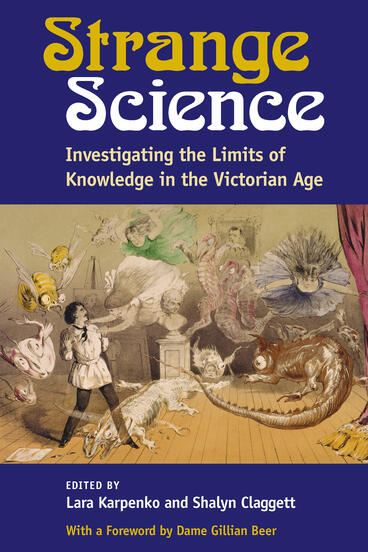I came across this in the course of my library work, and thought some here might find it interesting or useful in their research for fiction set in the period.-- Pat D.
Strange Science
Investigating the Limits of Knowledge in the Victorian Age
Edited by Lara Karpenko and Shalyn Claggett
With a Foreword by Dame Gillian Beer
A fascinating look at scientific inquiry during the Victorian period and the shifting boundary between mainstream and unorthodox sciences of the time
[This title is open access and free to read on the web This open access version made available with the support of libraries participating in Knowledge Unlatched.]
Description
The essays in Strange Science examine marginal, fringe, and unconventional forms of scientific inquiry, as well as their cultural representations, in the Victorian period. Although now relegated to the category of the pseudoscientific, fields like mesmerism and psychical research captured the imagination of the Victorian public. Conversely, many branches of science now viewed as uncontroversial, such as physics and botany, were often associated with unorthodox methods of inquiry. Whether ultimately incorporated into mainstream scientific thought or categorized by 21st century historians as pseudo- or even anti-scientific, these sciences generated conversation, enthusiasm, and controversy within Victorian society.
To date, scholarship addressing Victorian pseudoscience tends to focus either on a particular popular science within its social context or on how mainstream scientific practice distinguished itself from more contested forms. Strange Science takes a different approach by placing a range of sciences in conversation with one another and examining the similar unconventional methods of inquiry adopted by both now-established scientific fields and their marginalized counterparts during the Victorian period. In doing so, Strange Science reveals the degree to which scientific discourse of this period was radically speculative, frequently attempting to challenge or extend the apparent boundaries of the natural world. This interdisciplinary collection will appeal to scholars in the fields of Victorian literature, cultural studies, the history of the body, and the history of science.
“A valuable reflection on the changing conception of science that emerged in the nineteenth century and helped shape the modern world. . . . From the orthodox to the bizarre, the ‘strange science’ covered in this collection reminds us that the category of ‘science’ itself was being negotiated throughout the century.”
—Jay Clayton, Vanderbilt University
Strange Science
Investigating the Limits of Knowledge in the Victorian Age
Edited by Lara Karpenko and Shalyn Claggett
With a Foreword by Dame Gillian Beer
A fascinating look at scientific inquiry during the Victorian period and the shifting boundary between mainstream and unorthodox sciences of the time
[This title is open access and free to read on the web This open access version made available with the support of libraries participating in Knowledge Unlatched.]
Description
The essays in Strange Science examine marginal, fringe, and unconventional forms of scientific inquiry, as well as their cultural representations, in the Victorian period. Although now relegated to the category of the pseudoscientific, fields like mesmerism and psychical research captured the imagination of the Victorian public. Conversely, many branches of science now viewed as uncontroversial, such as physics and botany, were often associated with unorthodox methods of inquiry. Whether ultimately incorporated into mainstream scientific thought or categorized by 21st century historians as pseudo- or even anti-scientific, these sciences generated conversation, enthusiasm, and controversy within Victorian society.
To date, scholarship addressing Victorian pseudoscience tends to focus either on a particular popular science within its social context or on how mainstream scientific practice distinguished itself from more contested forms. Strange Science takes a different approach by placing a range of sciences in conversation with one another and examining the similar unconventional methods of inquiry adopted by both now-established scientific fields and their marginalized counterparts during the Victorian period. In doing so, Strange Science reveals the degree to which scientific discourse of this period was radically speculative, frequently attempting to challenge or extend the apparent boundaries of the natural world. This interdisciplinary collection will appeal to scholars in the fields of Victorian literature, cultural studies, the history of the body, and the history of science.
“A valuable reflection on the changing conception of science that emerged in the nineteenth century and helped shape the modern world. . . . From the orthodox to the bizarre, the ‘strange science’ covered in this collection reminds us that the category of ‘science’ itself was being negotiated throughout the century.”
—Jay Clayton, Vanderbilt University


Comment